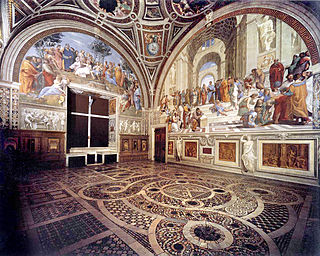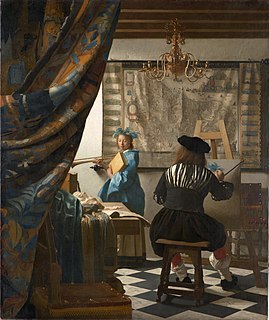
Graphic design is the process of visual communication and problem-solving through the use of typography, photography, and illustration. The field is considered a subset of visual communication and communication design, but sometimes the term "graphic design" is used synonymously. Graphic designers create and combine symbols, images and text to form visual representations of ideas and messages. They use typography, visual arts, and page layout techniques to create visual compositions. Common uses of graphic design include corporate design, editorial design, wayfinding or environmental design, advertising, web design, communication design, product packaging, and signage.
Mise-en-scène is an expression used to describe the design aspect of a theatre or film production, which essentially means "visual theme" or "telling a story"—both in visually artful ways through storyboarding, cinematography and stage design, and in poetically artful ways through direction. It is also commonly used to refer to single scenes within the film to represent the film. Mise-en-scène has been called film criticism's "grand undefined term".

In art history, the High Renaissance is a short period of the most exceptional artistic production in the Italian states, particularly Rome, capital of the Papal States, and in Florence, during the Italian Renaissance. Most art historians state that the High Renaissance started around 1495 or 1500 and ended in 1520 with the death of Raphael, although some say the High Renaissance ended about 1525, or in 1527 with the Sack of Rome by the army of Charles V, Holy Roman Emperor, or about 1530. The best-known exponents of painting, sculpture and architecture of the High Renaissance include Leonardo da Vinci, Michelangelo, Raphael and Bramante. In recent years, the use of the term has been frequently criticized by some academic art historians for oversimplifying artistic developments, ignoring historical context, and focusing only on a few iconic works.
ISO 9241 is a multi-part standard from the International Organization for Standardization (ISO) covering ergonomics of human-computer interaction. It is managed by the ISO Technical Committee 159. It was originally titled Ergonomic requirements for office work with visual display terminals (VDTs). From 2006 on, the standards were retitled to the more generic Ergonomics of Human System Interaction.
Communication design is a mixed discipline between design and information-development which is concerned with how media intervention such as printed, crafted, electronic media or presentations communicate with people. A communication design approach is not only concerned with developing the message aside from the aesthetics in media, but also with creating new media channels to ensure the message reaches the target audience. Some designers use graphic design and communication design interchangeably due to overlapping skills.

Negative space, in art, is the space around and between the subject(s) of an image. Negative space may be most evident when the space around a subject, not the subject itself, forms an interesting or artistically relevant shape, and such space occasionally is used to artistic effect as the "real" subject of an image.

Floral design or flower arrangement is the art of using plant materials and flowers to create a pleasing and balanced composition. Evidence of refined floristry is found as far back as the culture of ancient Egypt. Professionally designed floral designs, arrangements or artwork incorporate the elements of floral design: line, form, space, texture, and color, and the principles of floral design: balance, proportion, rhythm, contrast, harmony, and unity.

Piet Zwart was a Dutch photographer, typographer, and industrial designer.
Visual design elements and principles describe fundamental ideas about the practice of visual design.
"The best designers sometimes disregard the principles of design. When they do so, however, there is usually some compensating merit attained at the cost of the violation. Unless you are certain of doing as well, it is best to abide by the principles."
A work of art can be analyzed by considering a variety of aspects of it individually. These aspects are often called the elements of art. A commonly used list of the main elements includes form, shape, line, color, value, space, texture and perspective. The list can also be shortened to just five elements consisting of line, form, texture, colour and pattern.
AP Studio Art is a series of Advanced Placement Courses divided into three different categories: AP Studio Art Drawing, AP Studio Art 2D Design, and AP Studio Art 3D Design.

The following outline is provided as an overview of and topical guide to the visual arts:
The American Institute of Floral Designers (AIFD), established in 1965, is the oldest and largest non-profit organization dedicated to recognizing and promoting the art of floral design as a professional career. Its more than 1200 members engage in a variety of professional programs and activities through a network of six (6) regional chapters throughout the United States and Canada.
The University of Santo Tomas College of Fine Arts and Design, popularly known as "UST–CFAD", is the fine arts school of the University of Santo Tomas, the oldest and the largest Catholic university in Manila, Philippines.
In the visual arts, texture is the perceived surface quality of a work of art. It is an element of two-dimensional and three-dimensional designs and is distinguished by its perceived visual and physical properties. Use of texture, along with other elements of design, can convey a variety of messages and emotions.
In the visual arts, shape is a flat, enclosed area of an artwork created through lines, textures, colours or an area enclosed by other shapes such as triangles, circles, and squares. Likewise, a form can refer to a three-dimensional composition or object within a three-dimensional composition.

Albanian University of Arts is the main institution that offers higher education in the arts in Albania.

The visual arts are art forms such as painting, drawing, printmaking, sculpture, ceramics, photography, video, filmmaking, design, crafts, and architecture. Many artistic disciplines such as performing arts, conceptual art, textile arts also involve aspects of visual arts as well as arts of other types. Also included within the visual arts are the applied arts such as industrial design, graphic design, fashion design, interior design and decorative art.
NIU College of Visual and Performing Arts is composed of three schools, each with award-winning educational programs, performances, and exhibits. The college also administers several university programs including, the NIU Art Museum, the NIU Community School of Arts, and NIU Huskie Marching Band.








